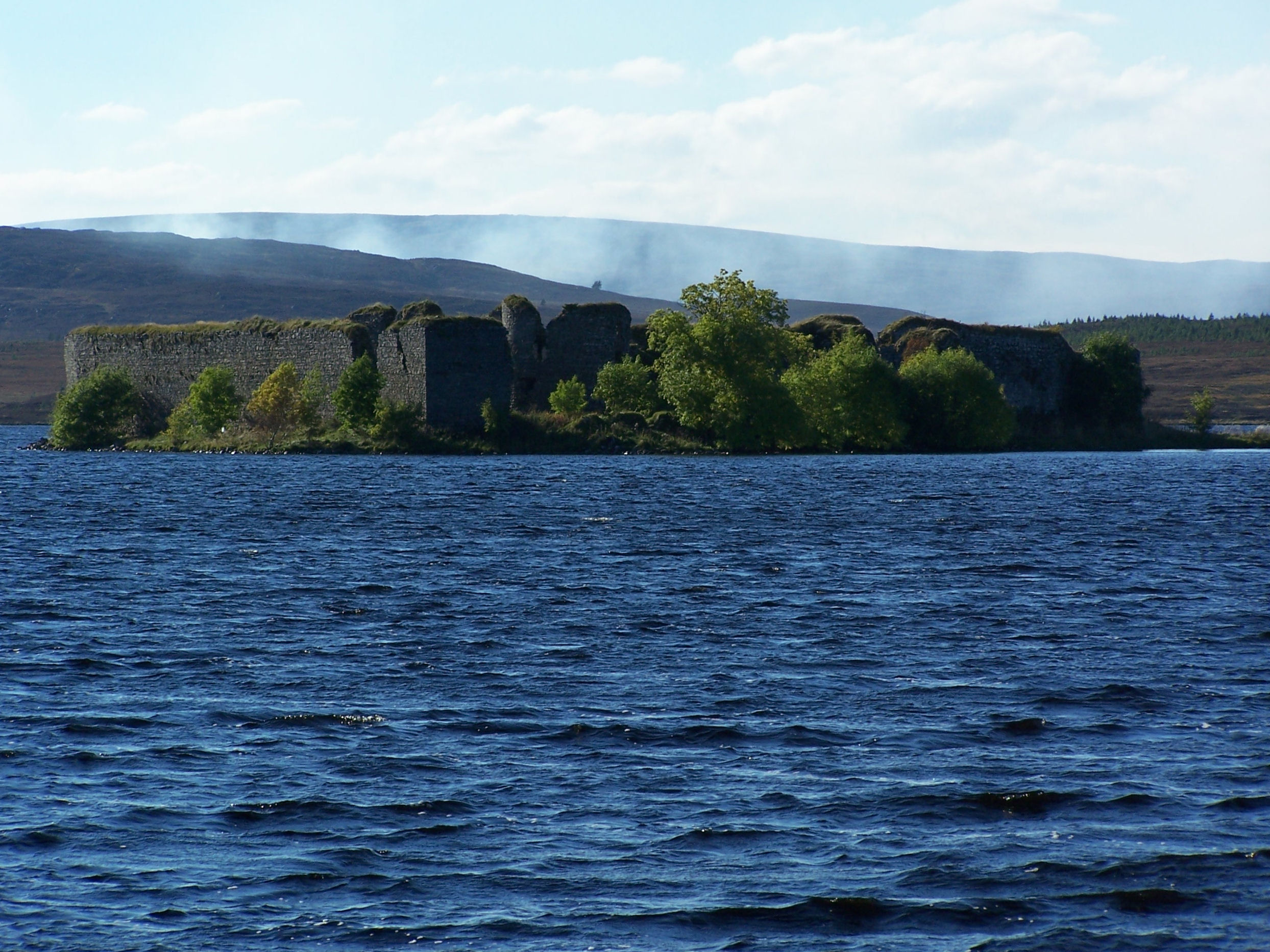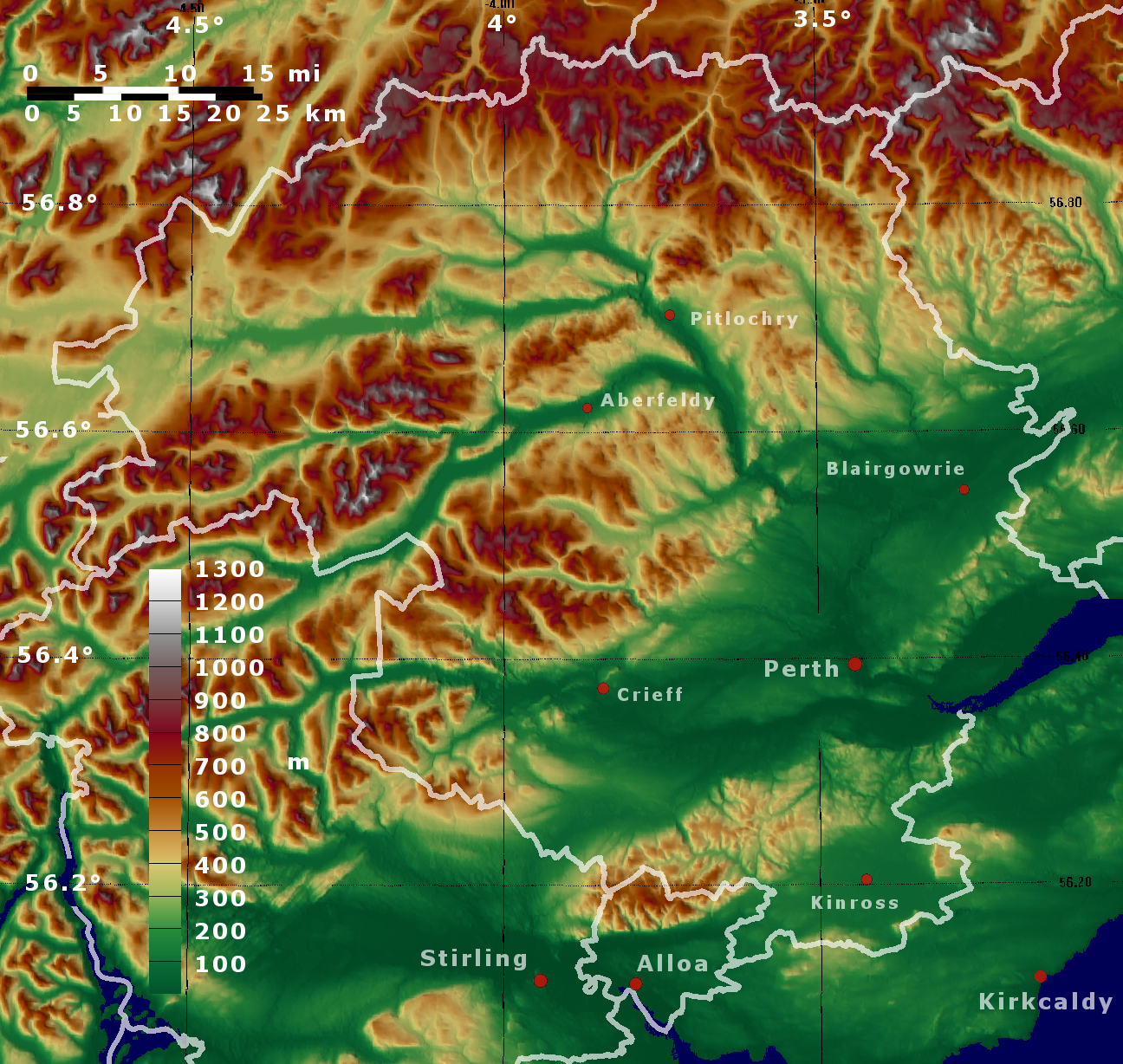|
Wolfhill
Wolfhill is a village in Perthshire, Scotland, with a population of 316 (2001 census). Formerly known as Carolina, it was given the nickname of "Snipetown" many years ago by locals, owing to the high numbers of snipes that used to inhabit the area. The hamlet is near the source of the Burrelton Burn and lies between the Sidlaw Hills and the River Tay, 2 miles (3 km) north east of Guildtown and 7 miles (11 km) north-east of Perth. Close to Wolfhill are examples of pre-historic standing stones. One of the best-known sites in folklore is "The Witches' Stane" located between Wolfhill and St Martins. According to local legend, this was the stone to which Macbeth's witches were chained, and it does indeed bear chain marks. "MacBeth's Castle" (a hill fort) can be found at the nearby village of Collace, near the Council Quarry on the Sidlaws. There are varying stories on how the village got its name, one being that the "Wolf of Badenoch" (Alexander Stewart, Earl of Buchan) c ... [...More Info...] [...Related Items...] OR: [Wikipedia] [Google] [Baidu] |
Guildtown
Guildtown is a village in Perth and Kinross, Scotland, founded in the year 1818 by the Guildry Incorporation of Perth. It is located roughly north of Perth, Scotland, Perth and south of Blairgowrie and Rattray, Blairgowrie on the A93 road, A93 road. It has a population of between 270 and 400 people. In 2018, it celebrated its bicentennial, commemorated by a road sign at the south end of the village. Geography On a map Guildtown is vaguely shaped like the letter Y, with Main Road (A93) running north until it joins Wolfhill Road from the north-east, as Main Road turns north-west. To the east of the village there is the Blackfaulds Stone Circle, consisting of 10 stones. Facilities Guildtown Primary School and Nursery A small primary school with a single classroom, a library and a kitchen. It also serves the nearby villages of Wolfhill, Newmiln and St Martins. It is a feeder school for Perth Academy. The second classroom was recently converted into a nursery. It does not ... [...More Info...] [...Related Items...] OR: [Wikipedia] [Google] [Baidu] |
James Croll
James Croll, FRS, (2 January 1821 – 15 December 1890) was a 19th-century Scottish scientist who developed a theory of climate variability based on changes in the Earth's orbit. Life James Croll was born in 1821 on the farm of Little Whitefield, near Wolfhill in Perthshire, Scotland, the son of David Croll, mason, and his wife Janet Geddes. He was largely self-educated. At 16 he became an apprentice wheelwright at Collace near Wolfhill, and then because of health problems a tea merchant in Elgin, Moray. In 1848 he married Isabella Macdonald, daughter of John Macdonald and Annabella Sime, of Forres. In the 1850s he managed a temperance hotel in Blairgowrie, and was then an insurance agent in Glasgow, Edinburgh and Leicester. In 1859, he became a janitor at the museum of the Andersonian University in Glasgow. He was able to use the university library to get access to books, and taught himself physics and astronomy to develop his ideas. From 1864, Croll corresponded ... [...More Info...] [...Related Items...] OR: [Wikipedia] [Google] [Baidu] |
Perthshire
Perthshire (Scottish English, locally: ; ), officially the County of Perth, is a Shires of Scotland, historic county and registration county in central Scotland. Geographically it extends from Strathmore, Angus and Perth & Kinross, Strathmore in the east, to the Pass of Drumochter in the north, Rannoch Moor and Ben Lui in the west, and Aberfoyle, Scotland, Aberfoyle in the south; it borders the counties of Inverness-shire and Aberdeenshire to the north, Angus, Scotland, Angus to the east, Fife, Kinross-shire, Clackmannanshire, Stirlingshire and Dunbartonshire to the south and Argyllshire to the west. Perthshire is known as the "big county", or "the Shire", due to its roundness and status as the fourth List of Scottish counties by area, largest historic county in Scotland. It has a wide variety of landscapes, from the rich agricultural straths in the east, to the high mountains of the southern Scottish Highlands, Highlands. History Administrative history Perthshire's origins a ... [...More Info...] [...Related Items...] OR: [Wikipedia] [Google] [Baidu] |
Hill Fort
A hillfort is a type of fortification, fortified refuge or defended settlement located to exploit a rise in elevation for defensive advantage. They are typical of the late Bronze Age Europe, European Bronze Age and Iron Age Europe, Iron Age. Some were used in the post-Roman Empire, Roman period. The fortification usually follows the contours of a hill and consists of one or more lines of Earthworks (Archaeology), earthworks or stone Rampart (fortification), ramparts, with stockades or defensive walls, and external ditches. If enemies were approaching, the inhabitants would spot them from a distance. Prehistoric Europe saw a growing population. It has been estimated that in about 5000 BC during the Neolithic between 2 million and 5 million lived in Europe; in the Late Iron Age it had an estimated population of around 15 to 30 million. Outside Greece and Italy, which were more densely populated, the vast majority of settlements in the Iron Age were small, with ... [...More Info...] [...Related Items...] OR: [Wikipedia] [Google] [Baidu] |
Lease
A lease is a contractual arrangement calling for the user (referred to as the ''lessee'') to pay the owner (referred to as the ''lessor'') for the use of an asset. Property, buildings and vehicles are common assets that are leased. Industrial or business equipment are also leased. In essence, a lease agreement is a contract between two parties: the lessor and the lessee. The lessor is the legal owner of the asset, while the lessee obtains the right to use the asset in return for regular rental payments. The lessee also agrees to abide by various conditions regarding their use of the property or equipment. For example, a person leasing a car may agree to the condition that the car will only be used for personal use. The term rental agreement can refer to two kinds of leases: * A lease in which the asset is tangible property. Here, the user '' rents'' the asset (e.g. land or goods) ''let out'' or ''rented out'' by the owner (the verb ''to lease'' is less precise because it c ... [...More Info...] [...Related Items...] OR: [Wikipedia] [Google] [Baidu] |
Coupar Angus Abbey
Coupar Angus Abbey was a Cistercian monastery near Coupar Angus, in central Scotland, on the boundary between Angus and Gowrie. It was founded on the old royal manor of Coupar in 1161 to 1162 with the patronage of Máel Coluim IV ("Malcolm IV"), King of Scots, by Cistercian monks from Melrose Abbey. However, it may not have been fully established until 1164. The buildings must have been largely completed by 1233, when the church was dedicated. It became an abbey of medium to large size and wealth and enjoyed more than four centuries of monastic life. In the 14th century it suffered in the wars with England, one of its granges reportedly being burnt by Edward I in 1305. In 1351 the buildings were described in a papal bull as "exceedingly impoverished." Its fortunes revived later in the middle ages, with at least 24 monks at the Reformation and an income of £5590. This made it the wealthiest Cistercian house in Scotland. In 1559 the abbey was entrusted by Abbot Donald Camp ... [...More Info...] [...Related Items...] OR: [Wikipedia] [Google] [Baidu] |
Wolf
The wolf (''Canis lupus''; : wolves), also known as the grey wolf or gray wolf, is a Canis, canine native to Eurasia and North America. More than thirty subspecies of Canis lupus, subspecies of ''Canis lupus'' have been recognized, including the dog and dingo, though grey wolves, as popularly understood, only comprise Wild type, naturally-occurring wild subspecies. The wolf is the largest wild Neontology, extant member of the family Canidae, and is further distinguished from other ''Canis'' species by its less pointed ears and muzzle, as well as a shorter torso and a longer tail. The wolf is nonetheless related closely enough to smaller ''Canis'' species, such as the coyote and the golden jackal, to produce fertile Canid hybrid, hybrids with them. The wolf's fur is usually mottled white, brown, grey, and black, although subspecies in the arctic region may be nearly all white. Of all members of the genus ''Canis'', the wolf is most Generalist and specialist species, specializ ... [...More Info...] [...Related Items...] OR: [Wikipedia] [Google] [Baidu] |
Dunkeld Cathedral
Dunkeld Cathedral is a Church of Scotland place of worship which stands on the north bank of the River Tay in Dunkeld, Perth and Kinross, Scotland. Built in square-stone style of predominantly grey sandstone, the cathedral proper began in 1260 and was completed in 1501. It stands on the site of the former Culdee Monastery of Dunkeld, stones from which can be seen as an irregular reddish streak in the eastern gable. It is not formally a 'cathedral', as the Church of Scotland nowadays has neither cathedrals nor bishops, but it is one of a number of similar former cathedrals which has continued to carry the name. History Because of the long construction period, the cathedral shows mixed architecture. Gothic architecture, Gothic and Norman architecture, Norman elements are intermingled throughout the structure. Although partly in ruins, the cathedral is in regular use today and is open to the public. Relics of Columba, Saint Columba, including his bones, were said to have been ke ... [...More Info...] [...Related Items...] OR: [Wikipedia] [Google] [Baidu] |
Alexander Stewart, Earl Of Buchan
Alexander Stewart, Earl of Buchan, called the Wolf of Badenoch (1343 – July 1394), was a Scottish royal prince, the third son of King Robert II of Scotland by his first wife Elizabeth Mure. He was Justiciar of Scotia and held large territories in the north of Scotland. He is best remembered for his destruction of the royal burgh of Elgin and its cathedral. His sobriquet was given due to his notorious cruelty and rapacity, but there is no proof that it was used during his lifetime. Power and influence Known in charters as Alexander ''Senescalli'' (Latin for Steward), first noted when, on 14 August 1370, he issued letters patent from Ruthven Castle undertaking to grant protection to the Bishop of Moray and all of his lands, men and property in Badenoch. His father, Robert the Steward, had acquired the lands of Badenoch probably from Euphemia, Countess of Moray who had become his second wife. Robert had a petulant relationship with his uncle, King David II of Scotland.S. I. ... [...More Info...] [...Related Items...] OR: [Wikipedia] [Google] [Baidu] |
Collace
Collace () is a parish in Perthshire, Scotland, northeast of Perth, in Strathmore. The parish boundary includes the neighbouring villages of Kinrossie and Saucher. The traditional industries of the area are farming, quarrying (sandstone) and weaving, but the latter is now gone. Dunsinane Hill, mentioned in the Shakespeare play ''Macbeth'', is located near Collace. King's Seat, a low hill east of the village, is marked romantically on older maps as "Macbeth's Castle". Bandirran Stone Circle stands just south of the village. Buildings The currenCollace parish churchbuilding dates from 1812 to 1813 and is on the site of an earlier church dedicated in 1242. Four stained glass windows from 1919 depict scenes from the life of Christ. In the graveyard are important 17th- and 18th-century gravestones, a rare medieval Discoid stone and a conserved mort-house. Next to the church are the remains of a medieval building with a Romanesque arch which was used as the mausoleum for t ... [...More Info...] [...Related Items...] OR: [Wikipedia] [Google] [Baidu] |
Perth And Kinross
Perth and Kinross (; ) is one of the 32 council areas of Scotland, and a Lieutenancy areas of Scotland, lieutenancy area. It is bordered by Highland (council area), Highland and Aberdeenshire to the north, Angus, Scotland, Angus, Dundee, and Fife to the east, Clackmannanshire to the south, and Stirling (council area), Stirling and Argyll and Bute to the west. Geographically the area is split by the Highland Boundary Fault into a more mountainous northern part and a flatter southern part. The northern area is a popular tourist spot, while agriculture makes an important contribution to the southern part of the area. The area is run by Perth and Kinross Council, which is based in Perth, Scotland, Perth. History The area takes its name from the two historical Shires of Scotland, shires of Perthshire and Kinross-shire. Each was administered by a Sheriff principal, sheriff from medieval times, supplemented by Commissioners of Supply, commissioners of supply from 1667 and then by a ... [...More Info...] [...Related Items...] OR: [Wikipedia] [Google] [Baidu] |
Macbeth
''The Tragedy of Macbeth'', often shortened to ''Macbeth'' (), is a tragedy by William Shakespeare, estimated to have been first performed in 1606. It dramatises the physically violent and damaging psychological effects of political ambitions and power. It was first published in the Folio of 1623, possibly from a prompt book, and is Shakespeare's shortest tragedy. Scholars believe ''Macbeth'', of all the plays that Shakespeare wrote during the reign of King James I, contains the most allusions to James, patron of Shakespeare's acting company. In the play, a brave Scottish general named Macbeth receives a prophecy from a trio of witches that one day he will become King of Scotland. Consumed by ambition and spurred to violence by his wife, Macbeth murders the king and takes the Scottish throne for himself. Then, racked with guilt and paranoia, he commits further violent murders to protect himself from enmity and suspicion, soon becoming a tyrannical ruler. The bloo ... [...More Info...] [...Related Items...] OR: [Wikipedia] [Google] [Baidu] |








